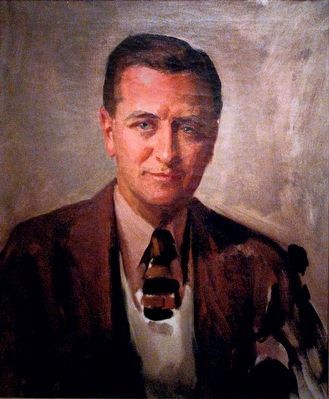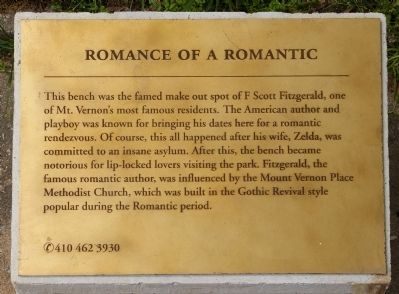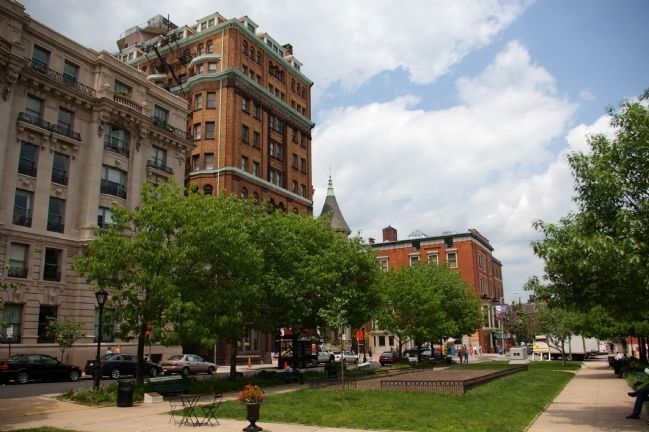Mount Vernon in Baltimore, Maryland — The American Northeast (Mid-Atlantic)
Romance of a Romantic
📞 410 462 3930
Topics. This historical marker is listed in these topic lists: Arts, Letters, Music • Churches & Religion • Science & Medicine.
Location. Marker has been permanently removed. It was located near 39° 17.884′ N, 76° 36.947′ W. Marker was in Baltimore, Maryland. It was in Mount Vernon. Marker could be reached from Washington Place, in the median. Touch for map. Marker was in this post office area: Baltimore MD 21201, United States of America.
We have been informed that this sign or monument is no longer there and will not be replaced. This page is an archival view of what was.
Other nearby markers. At least 8 other markers are within walking distance of this location. The American Psychoanalytic Association (within shouting distance of this marker); John Eager Howard (within shouting distance of this marker); Mount Vernon Place United Methodist Church (within shouting distance of this marker); Francis Scott Key (within shouting distance of this marker); Celebrating Culture: The Heart of the City / Contributing to Society: Baltimore's Best Address (within shouting distance of this marker); Welcome to the Washington Monument and Mount Vernon Place (within shouting distance of this marker); Asbury House (within shouting distance of this marker); Washington Monument (within shouting distance of this marker). Touch for a list and map of all markers in Baltimore.
Related markers. Click here for a list of markers that are related to this marker.
Additional commentary.
1. George Washington's axe
Some suspect that the story of this park bench is similar to the one told of the axe that belonged to George Washington - yes, the head has been replaced a few times, and so has the handle, but it was Washington's axe.
— Submitted May 16, 2008, by Christopher Busta-Peck of Shaker Heights, Ohio.
2. Beyond the Compass, Beyond the Square: Mapping History
This "historical marker" was one of seven installed by Maryland Institute College of Art sophomore Daniel Allende as part of the 2008 exhibit Beyond the Compass, Beyond the Square. While the text of the markers has some basis in truth, the exaggerations become quickly apparent when one takes the time to read the text. In addition to the insight the marker provides about the history of Mount Vernon Square, it also helps to illustrate how often historical markers are taken for granted, almost unseen, and how they could say most anything, yet still be unnoticed.
— Submitted June 4, 2008, by Christopher Busta-Peck of Shaker Heights, Ohio.

Photographed By Allen C. Browne, November 2, 2011
3. F. Scott Fitzgerald
This 1935 portrait of F. Scott Fitzgerald by David Silverette hangs in the National Portrait Gallery in Washington, DC
“It was F. Scott Fitzgerald who named the selfindulgent 1920s the Jazz Age, and his best-selling novel This Side of Paradise became one of the decade's first literary landmarks. But his most enduring achievement was The Great Gatsby (1925), which, in meticulously crafted prose, wove a modern morality tale set against a backdrop of luxury. Fitzgerald and his talented wife, Zelda, experienced — in New York, Paris, and Hollywood some of the glamorous life he evoked. But struggling with financial disappointments, alcoholism, and Zelda's mental illness, Fitzgerald also probed the destructive underside of the era's bright illusions. When he met artist David Silvette in 1935, Fitzgerald was suffering from an emotional breakdown. He agreed to pose, however, and considered this a swell portrait. His career as chronicler of the dreams and disappointments of contemporary life was cut short by his death five years later.” — National Portrait Gallery
“It was F. Scott Fitzgerald who named the selfindulgent 1920s the Jazz Age, and his best-selling novel This Side of Paradise became one of the decade's first literary landmarks. But his most enduring achievement was The Great Gatsby (1925), which, in meticulously crafted prose, wove a modern morality tale set against a backdrop of luxury. Fitzgerald and his talented wife, Zelda, experienced — in New York, Paris, and Hollywood some of the glamorous life he evoked. But struggling with financial disappointments, alcoholism, and Zelda's mental illness, Fitzgerald also probed the destructive underside of the era's bright illusions. When he met artist David Silvette in 1935, Fitzgerald was suffering from an emotional breakdown. He agreed to pose, however, and considered this a swell portrait. His career as chronicler of the dreams and disappointments of contemporary life was cut short by his death five years later.” — National Portrait Gallery
Credits. This page was last revised on April 17, 2020. It was originally submitted on May 16, 2008, by Christopher Busta-Peck of Shaker Heights, Ohio. This page has been viewed 1,528 times since then and 4 times this year. Photos: 1, 2. submitted on May 16, 2008, by Christopher Busta-Peck of Shaker Heights, Ohio. 3. submitted on October 12, 2015, by Allen C. Browne of Silver Spring, Maryland.

